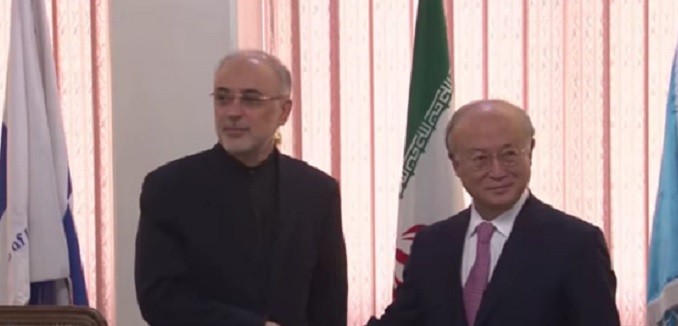Officials from the UN’s International Atomic Energy Agency (IAEA) nuclear watchdog disclosed on Friday that they had demanded more information from Iranian officials regarding tests on detonators – specifically, on Exploding Bridge Wire (EBW) detonators – suspected of having been conducted with the aim of creating nuclear warheads, the latest development in an emerging controversy over Tehran’s willingness to disclose a range of widely suspected “possible military dimensions” (PMD).
The Islamic republic is obligated to provide transparency into PMD-related activities by United Nations Security Council resolution 1929, and non-compliance with those obligations has been cited by U.S. lawmakers as a central justification for maintaining pressure on Tehran.
President Barack Obama had as early as 2009 declared that Iran would have to “come clean” in disclosing all past nuclear activities, language that was explicitly echoed by Secretary of State John Kerry on the eve of announcing the interim Joint Plan of Action (JPA), under which Iran received sanctions relief in exchange for slowing down its nuclear progress. The JPA however did not include any requirement that Iran meet its PMD obligations, and was criticized on precisely that account by among others Washington Institute Executive Director Robert Satloff:
“I’m surprised getting Iran to come clean on all its past clandestine programs wasn’t a clear achievement in this deal,” said Robert Satloff, executive director of Washington Institute for Near East Policy.
The deal makes no mention of a potential military action if Iran does not live up to its obligations, meaning a “credible use of force now seems removed from this diplomacy,” Satloff said.
Satloff’s comments were echoed by Mark Dubowitz and Orde Kittrie, respectively the executive director of the Foundation for Defense of Democracies and a senior fellow at the foundation.
Top administration officials pushed back by insisting that the JPA had only been meant to facilitate negotiations, and that Iran would be forced to meet its PMD obligations in the context of a final agreement. Observers have become increasingly concerned in recent weeks that a range of Iranian moves appear aimed at delaying discussion of PMD activities until after most other issues have been resolved, at which point Iranian negotiators would refuse to meet their transparency obligations and functionally dare the West to scuttle an emerging deal over what they would characterize as past work.
There are now suggestions floating in corners of the foreign policy community that a final agreement may exclude the PMD issue:
However, it has been alleged that in the enthusiasm for a comprehensive agreement, the P5+1 could ignore the PMD aspect if all other conditions are met. It could stand to reason that if Iran’s break-out capability is indefinitely delayed and the technology available to it is severely limited, in addition to greater transparency and IAEA access to its facilities, the PMD question may not have to be directly dealt with at all. In addition, even if the P5+1 agree to discuss theissue, Iran is unlikely to admit to any such activity in the fear of a backlash, and due to its fatwa against nuclear weapons.
Analysts nonetheless have been emphatic that the success of any deal, and especially any agreement that would lean heavily on verification mechanisms, would require extensive disclosure in the context of untangling the Iranian military from the country’s atomic program. Washington Institute Managing Director Michael Singh explained months ago that “[w]ithout insight into the full extent of Iran’s clandestine nuclear activities, no amount of monitoring and inspection can provide true confidence that Iran lacks a parallel program beyond inspectors’ view.”
[Photo: Ruptly TV / YouTube]




